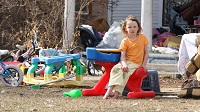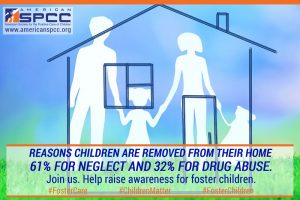Foster Care: What’s pushing more kids into Foster Care? | American SPCC

Tina Persinger’s office is a wooden desk in a thrift store in tiny Grantsville, a 7,000-or-so-resident town nestled between the winding, cell-signal-free hills of West Virginia. When Persinger was hired as director of Calhoun County’s Family Resource Network two years ago, the foster care system here was already ailing — state funding had been cut, and federal funds were withheld after the Mountain State flunked three of its last four federal reviews in the decade leading to 2012.
Unfortunately, the job has only gotten even more difficult. Persinger now works with around a dozen caseworkers.
THE NUMBER OF WEST VIRGINIA CHILDREN IN FOSTER CARE HAS GROWN BY 24 PERCENT BETWEEN 2012 AND 2016.
A representative for the West Virginia Department of Health and Human Services, which reported the increase, tells OZY there is “no formal mechanism” to track the effect of substance abuse. But Persinger has little doubt: “It used to be that 99 percent of the cases were neglect,” she says. “Now 99 percent are substance-abuse-related.”
This kind of increase isn’t just happening in West Virginia, of course. In opioid-plagued Ohio, almost 10,000 children are in foster care — with nearly half taken into custody last year having had a parent using drugs, according to the Pew Charitable Trusts. New Hampshire and Vermont passed laws to remove children from homes of addicts. Other states, including Alaska and Kansas, have made public pleas for foster parents to take neglected children — a difficult pitch considering such kids often have a higher risk for learning deficiencies and behavioral issues.
“ IT IS POSSIBLE TO KEEP THE MOM WITH A DRUG PROBLEM WITH HER KIDS — SO LONG AS SHE’S WILLING TO CHANGE.” LORI FLEAGLE, FAMILY CRISIS INTERVENTION CENTER EMPLOYEE
IT IS POSSIBLE TO KEEP THE MOM WITH A DRUG PROBLEM WITH HER KIDS — SO LONG AS SHE’S WILLING TO CHANGE.” LORI FLEAGLE, FAMILY CRISIS INTERVENTION CENTER EMPLOYEE
Across the nation, substance-abusing parents are introducing unique stresses on the foster care system. The number of children born addicted — their mothers used during pregnancy — has quadrupled in the past 15 years, according to the Centers for Disease Control and Prevention. Babies cry constantly as they undergo the throes of withdrawal and must spend weeks, even months, in dwindling neonatal pods. “They are not bonding with who is going to raise them,” Persinger says. “It’s very dangerous, and very costly to the system.” Despite being one of the poorest states in the country, West Virginia had 0.2 percent of its population in foster care in 2014 — a higher percentage than Alabama (.06), Louisiana (.09) or neighboring Kentucky (.17), according to the Kids Count Data Center. The laws weren’t so strict in the past, says Lori Fleagle, who counsels battered women at a Calhoun County family crisis intervention center. “I was a heroin addict 25 years ago, and I didn’t lose my kids,” she says. “My point is, it is possible to keep the mom with a drug problem with her kids — so long as she’s willing to change.”
But the shift, from neglect to addiction, complicates Safe at Home’s promise. “You can’t leave a child in an opiate home, where the parents are nodding off,” Persinger says. Even keeping children in-state doesn’t avoid culture-shift problems, especially for rural teenagers moving into shelters in much more racially diverse environments. “They don’t thrive, because they’re not used to that environment,” Persinger says, adding that the closest city — Parkersburg, with a population of 30,000 — is like “living in New York City, compared to living in Grantsville.”
Ways to Give
American SPCC is a 501(c) 3 top-rated nonprofit organization (federal tax ID 27-4621515).
Charitable donations are tax deductible.
http://americanspcc.org/foster-care-whats-pushing-kids-foster-care/
On – 30 May, 2017 By Sue






